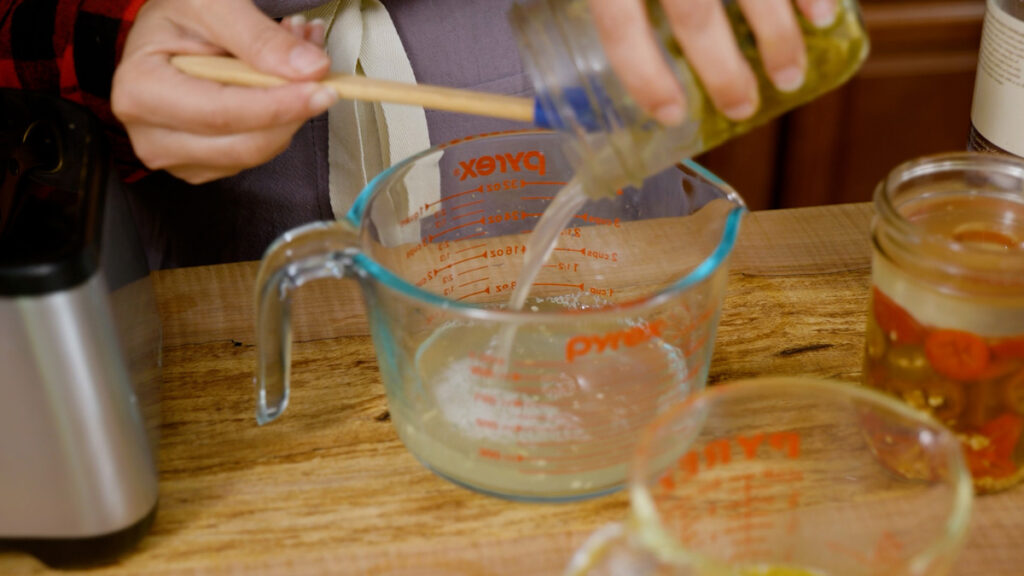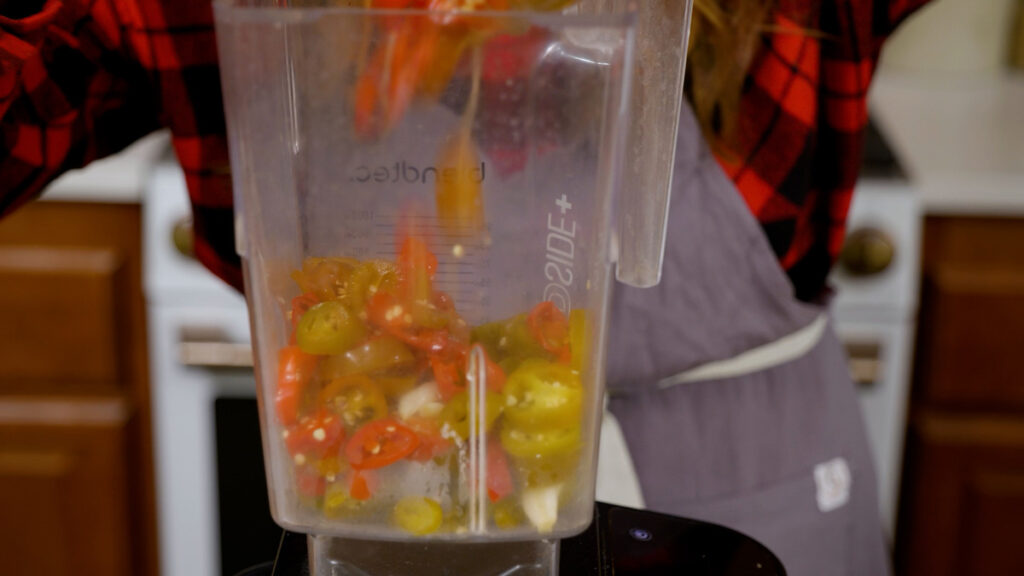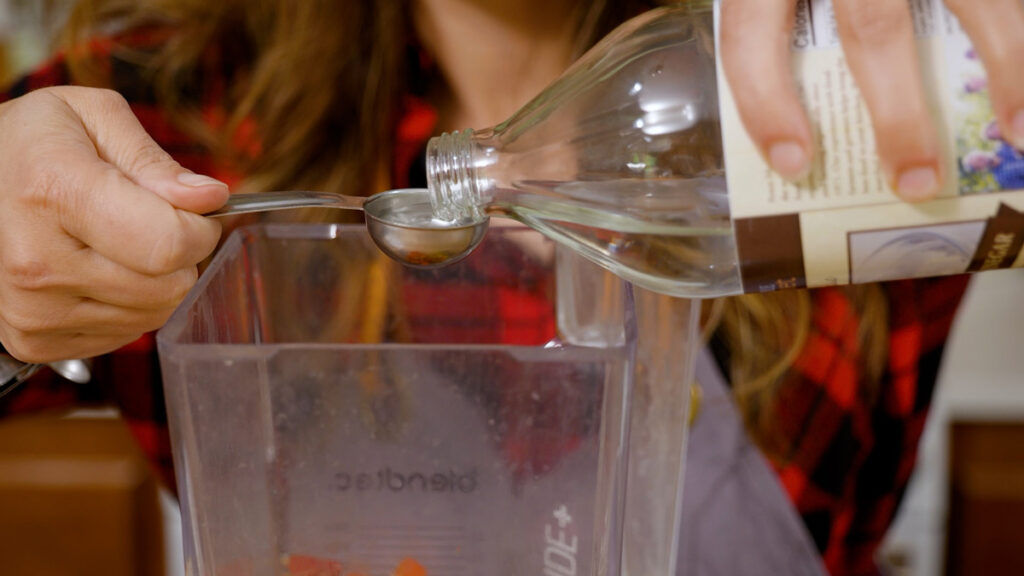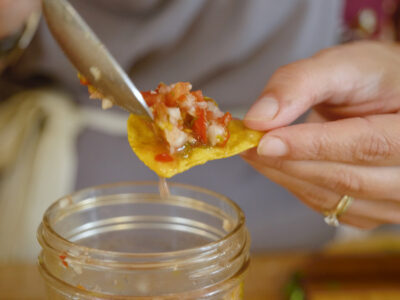I don’t claim to be a hot sauce enthusiast, but my husband is. And he told me this fermented hot sauce recipe is by far the best hot sauce he’s ever tasted. So, if you’ve been on the lookout for the next best thing, look no further. After many trials and errors, I have finally perfected my recipe for the best fermented hot sauce. Fermentation is the key to unlocking a whole new level of flavor in your hot sauce, and in this post, I will share my secrets with you.

If you were unsure of my love for fermented things, then perhaps you should check out some of my other fermented recipes. Furthermore, keep in mind that I wrote an entire book called Everything Worth Preserving with hundreds of fermented recipes included.
So naturally, making fermented hot sauce was a no-brainer! As a modern pioneer, I’m always looking for more items to cross off my grocery store list and make from scratch.
Why I Love This Recipe
The fermentation process is what sets fermented hot sauce apart from regular hot sauce. It starts by making my fermented peppers recipe. The fermentation process involves the use of lactic acid bacteria to break down the sugars and starches in the peppers, creating a complex and tangy flavor. The longer you ferment the sauce, the more intense the flavor becomes.
Now, if you are ready to take your hot sauce game to the next level, keep reading for the best fermented hot sauce recipe.
What is Fermented Hot Sauce?
Fermented hot sauce is made by allowing hot chili peppers (and sometimes other ingredients) to sit in a saltwater brine solution with lactic acid bacteria. This bacteria helps to break down the sugars and starches in the peppers and create new flavor compounds while also increasing the health benefits. (Source)
This fermentation process can take anywhere from a few days to several months, depending on the desired flavor and heat level.
When peppers are combined with the lactic acid bacteria, the capsaicin in the peppers can develop a complex flavor profile that’s unique to fermented hot sauce.
Pro Tip: Keep in mind that some of the hottest peppers (over 500,000 Scoville units) won’t ferment since capsaicin is actually bactericidal.

Why Ferment Your Hot Sauce?
Since my husband is a lover of hot sauce, I have experimented with many different recipes over the years. However, it wasn’t until I began fermenting my peppers that I truly discovered the full potential of this spicy condiment.
- Flavor – The fermentation process creates complex, tangy, and sour notes that add an extra dimension to the taste. It also allows the flavors of the chili peppers and other ingredients to develop and mature, resulting in a more well-rounded and balanced flavor profile.
- Nutrition – The fermentation process increases the nutritional value of the hot sauce. During fermentation, lactic acid bacteria break down the sugars and starches in the ingredients, creating beneficial enzymes and probiotics that aid digestion and boost the immune system. (Source)
- Shelf-Life – In addition to improving flavor and nutrition, fermenting hot sauce lengthens its shelf life. The natural preservation process of fermentation means that the sauce can last for months or even a year without artificial preservatives. This makes it an excellent way to preserve your garden’s bumper crop of chili peppers.
Store-Bought vs Homemade Hot Sauce
Surprisingly enough, many of the hot sauces purchased at the grocery store start as fermented hot sauce. Sadly, they’re then heat-processed for shelf-stable packaging, killing all the beneficial bacteria.
Though many store-bought hot sauces have decent ingredients, you’re still missing out on all the benefits of the fermentation process. By making hot sauce at home, we keep those beneficial microbes in the sauce, which then gets added as a delicious condiment to our food.


available now
Everything Worth Preserving
Take control of your food with Everything Worth Preserving by Melissa K. Norris! This ultimate guide to canning, fermenting, and more gives you the confidence to preserve food safely and sustainably. Don’t let your harvest go to waste—grab your copy today!
How to Make Fermented Hot Sauce
As I mentioned before, the best fermented hot sauce recipe starts with fermented peppers. Jump over to the blog post and start a batch today!

Supplies Needed
- Blender or Food Processor – Because hot sauce ought to be silky and smooth, the only way to reach that consistency is with a food processor or a high-powered blender.
- Strainer – You’ll want to strain your fermented peppers while reserving the brining liquid, so having a strainer helps catch the peppers.
- Hot Sauce Container – Any container will do, a swing-top bottle, a Mason jar with lid, or a fancy sauce container like I have in the video.

Ingredients Needed
- Fermented Peppers – Fermented peppers of any kind. My fermented peppers are jalapenos at various stages of ripeness. I kept the seeds for a little extra heat. When making your fermented peppers, you can remove the seeds and inner ribs of the pepper to reduce the heat.
- Fermented Garlic – When making fermented peppers I always add in a few cloves of garlic. These are delicious to eat as a snack, or they add a delicious garlic flavor to your hot sauce.
- Distilled White Vinegar – If you want to change the flavor profile of your hot sauce, you can use any vinegar or acid you’d like. I like the sharpness of the white distilled vinegar, but you could use apple cider vinegar, white wine vinegar, or even lemon or lime juice.
- Sweetener (optional) – If you like your hot sauce a little sweeter to help offset some of the heat, feel free to add one or two teaspoons of your favorite sweetener like honey, molasses, maple syrup or brown or white sugar. For my recipe, I chose to leave the sweetener out.
- Oil – If you want to offset the heat even further, adding oil to your hot sauce will help. I love the flavor profile of salted butter. Furthermore, because the butter will naturally harden when in the refrigerator, it will thicken the hot sauce without having to add thickeners like xanthan gum.
- Fermenting Brine – When emptying your jars of fermented peppers, be sure to reserve the brine. We’ll use this in the hot sauce recipe to help thin the sauce out to the perfect consistency. Start with the lowest amount and only add more if you need a thinner consistency. Pro Tip: You can always add more, but you can’t remove it if your hot sauce gets too runny! Remember that if you use butter, your hot sauce will thicken slightly once refrigerated.
Step-by-Step Directions
- Strain fermented peppers, reserving the brine and add four cups to a high-powered blender or food processor. If you have fermented garlic cloves, add those to the blender as well.
- Add vinegar, melted butter and two tablespoons of the reserved brine and blend until smooth.
- Check the consistency and add more brine until the desired consistency is reached. Pro Tip: Remember that if you use an oil that solidifies at cold temperatures, your hot sauce will thicken when placed in the refrigerator.
- Bottle and store in the refrigerator for 6-12 months.






Did you make this recipe? If so, please leave a star rating in the recipe card below. Your reviews really help me out. Also, snap a photo and tag me on social media @melissaknorris so I can see your finished fermented hot sauce recipes!

Frequently Asked Questions
How to Store Fermented Hot Sauce
Fermented hot sauce not only tastes fantastic, but it also has a long shelf life. Proper storage and preservation play a crucial role in maximizing its longevity.
A homemade fermented hot sauce can last up to a year if stored correctly. However, its lifespan also depends on ingredients, acidity levels, and preparation methods.
The best way to preserve fermented hot sauce is by storing it in airtight glass bottles or jars in a cool and dark place, such as the refrigerator. Avoid exposure to direct sunlight, heat, or moisture, as they can cause the sauce to spoil or lose quality.
I don’t recommend storing fermented hot sauce at room temperature.
Is My Hot Sauce Bad?
It’s essential to check the sauce regularly for signs of spoilage, such as mold growth or unusual odor. If you notice any of these signs, discard the sauce and make a new batch.
It’s possible you may see a white film form on the top of your hot sauce. This is most likely kahm yeast. You can read more about kahm yeast and whether it’s harmful or not here.
Fermented Hot Sauce vs Regular Hot Sauce
As someone who’s been making hot sauce for years, I can tell you that there is a big difference between fermented hot sauce and regular hot sauce. While regular hot sauce is made by combining chili peppers, vinegar, and other ingredients, fermented hot sauce is made using a fermentation process that enhances the flavor and creates a unique tangy taste.
The most noticeable difference between the two is the flavor profile. Regular hot sauce has a sharp and acidic taste due to the vinegar content, while fermented hot sauce has a more complex flavor profile that is often described as tangy or even fruity. The fermentation process creates a depth of flavor that cannot be achieved with regular hot sauce.
Fermented hot sauce has a thicker and smoother texture compared to regular hot sauce, which is often thin and watery. The fermentation process breaks down the chili peppers and allows for a smoother texture with a more even consistency.
Does Hot Sauce Get Hotter With Age?
One of the most common misconceptions about hot sauce is that it gets hotter with age. While it is true that some hot sauces may taste spicier over time, this is not due to an increase in capsaicin content.
Capsaicin is the compound responsible for the heat in hot peppers, and it does not typically increase with age. In fact, capsaicin can break down over time, which may actually result in a milder hot sauce.
However, there are a few reasons why some people may perceive hot sauce as hotter as it ages. One reason is that the flavors can become more concentrated as the water content evaporates over time, which can make the spiciness more noticeable.
Another reason is that our taste buds can become more desensitized to spicy foods over time, which can make previously mild hot sauce taste spicier.
So, does hot sauce get hotter with age? Not necessarily. While the flavors may become more intense and our perceptions may change, the actual capsaicin content does not typically increase over time.
More Posts You May Enjoy

Fermented Hot Sauce
Equipment
- Food Processor or High Powered Blender
Ingredients
- 4 cups fermented peppers
- 2 Tablespoons distilled white vinegar
- 4 Tablespoons butter melted
- 2 Tablespoons fermenting brine plus more, as needed
Instructions
- Strain fermented peppers, reserving the brine and add four cups to a high-powered blender or food processor. If you have fermented garlic cloves, add those to the blender as well.
- Add vinegar, melted butter and two tablespoons of the reserved brine and blend until smooth.
- Check the consistency and add more brine until the desired consistency is reached. Pro Tip: Remember that if you use an oil that solidifies at cold temperatures, your hot sauce will thicken when placed in the refrigerator.
- Bottle and store in the refrigerator for 6-12 months.
Notes
- Flavor – The fermentation process creates complex, tangy, and sour notes that add an extra dimension to the taste. It also allows the flavors of the chili peppers and other ingredients to develop and mature, resulting in a more well-rounded and balanced flavor profile.
- Nutrition – The fermentation process increases the nutritional value of the hot sauce. During fermentation, lactic acid bacteria break down the sugars and starches in the ingredients, creating beneficial enzymes and probiotics that aid digestion and boost the immune system. (Source)
- Shelf-Life – In addition to improving flavor and nutrition, fermenting hot sauce lengthens its shelf life. The natural preservation process of fermentation means that the sauce can last for months or even a year without artificial preservatives. This makes it an excellent way to preserve your garden’s bumper crop of chili peppers.













Who knew you could ferment hot sauce!? I LOVE IT! Never hurts for a few extra probiotics, right?
When you strain the peppers what do you do with the excess fermented brine from the jalapeños after adding 2tbls to the blender?
I have never heard of fermented hot sauce! This sounds so interesting, and I am intrigued to know what it tastes like!
I hope this doesn’t make me sound dumber that a post but do you use chili peppers or Bell peppers?
Stop laughing. ;o)
I used jalapenos
It would have been nice to start with instructions on how to ferment peppers and garlic first. I would think that would make all the difference in the world on the outcome of this recipe.
It’s linked to that tutorial in multiple spots throughout this recipe and the comment section
Melissa
unless my computer is being stupied i dont see the links like i normally do
Love this idea. How do you ferment the peppers?
https://melissaknorris.com/how-to-make-fermented-peppers/